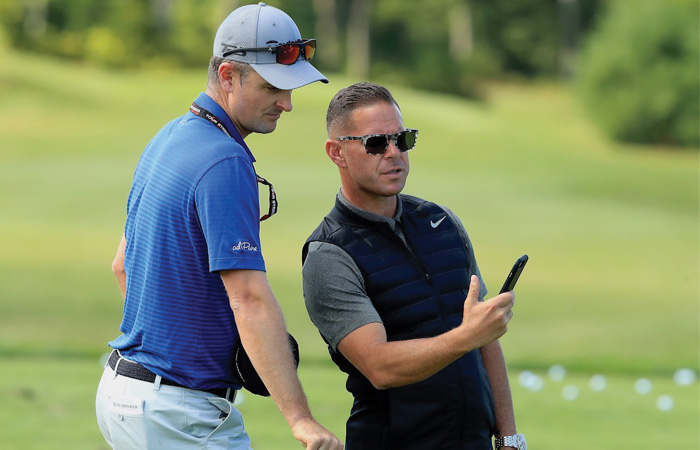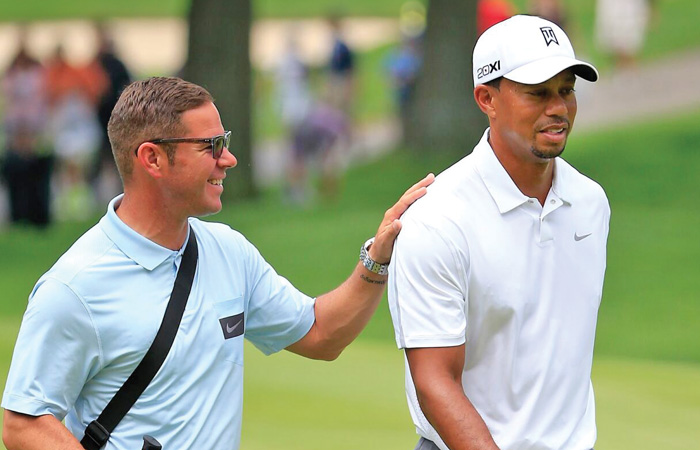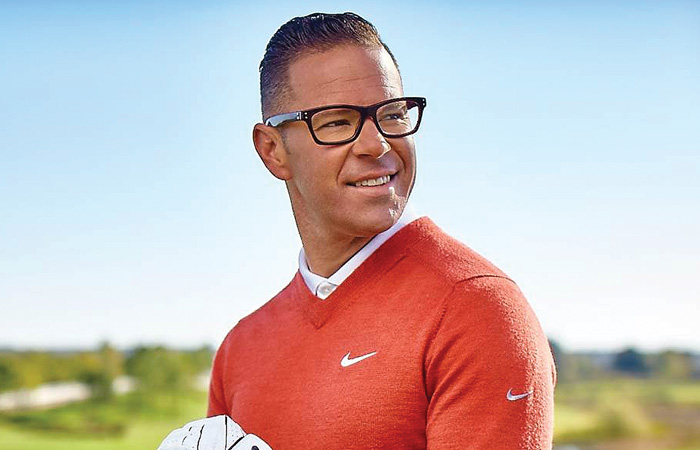If you come across a not-very-tall guy with slicked-back hair, colorful glasses that usually match his shirt, and many tattoos on his arms, what field might you imagine he is in? Before you get too carried away and imagine a hip-hop star, know that this man is extremely well-read and erudite. Also note that the tattoos are not some weapons-and-flowers -type symbols but deeply symbolic and from the many philosophies and religions he has studied on his way to becoming one of the world’s most respected golf teachers. He is none other than the famous Sean Foley, coach to many big-name players starting with Stephen Ames, and including Tiger Woods, Lydia Ko, Justin Rose, Cameron Champ, Michael Kim, Sam Horsfield, Danny Willett, Stephen Ames, Hunter Mahan, Sean O’Hair and most recently, Ben An and Erik van Rooyen.

Born in Canada, Sean’s family moved all over the U.S., and he was 10 years old and living in Los Angeles when his father first took him out to the driving range at the Vista Valencia golf course. That is how his early golf background was in The Golfing Machine style of golf swing, because one of its great proponents – Gregg McHatton – was and is – one of the principal coaches there.
Foley’s father, a chemist, had found that in those days golf was full of a lot of opinions without much research. Which is why he believed that The Golfing Machine would be a good place for Sean to start as, at least, it had some structure along with some specific ideas.
College opened Sean’s mind to many more swing ideas as well as life beliefs, because he went on a full scholarship to a Division I university to play golf and study political science and philosophy. Even his choice of college was as unique as he is, because Tennessee State University is an HBCU (Historically Black College /University). “I think I just learned to think differently,” Foley said. “I think philosophy really helped my career because I’m very open to different points of view … never really having a solid point of view, just kind of figuring things out and adding to it and taking things out.”
Moreover, Foley adds, “I was literally the only white kid who lived on campus. I just think I had so many Petri dishes of places to observe life from.” He also believes his family’s many moves from Canada to America to the South (of USA) to Los Angeles made him really lucky because he was able to see how different people felt about different things.

So how did this intriguing golf teacher, mentor and coach originally get all the ideas that he used when he first started teaching golf? “I probably read every Golf Magazine and Golf Digest, and I would also say that the fact that I hit like 300 to 400 balls a day for probably a decade. I learned a lot through trial and error.” And, he adds, “We’re all unique but we’re not that unique – what makes us human beings is pretty much all the same.” Sean believes that there might be two or three ways, but definitely not four, of getting the club square after all!
Over the years Foley has sought and found “his people” – the experts that he trusts for a scientific opinion including physiologists, osteopaths, chiropractors and two special mentors, Dr. Mark Bull and Chris Welch. Others he has spent time learning from include Dr. Sasho Mackenzie, Dr. Young Hoo Kwon and many golf teachers, including Kelvin Miyahara and George Gankas. He believes he has consulted a lot of people “smarter than me” and then put all of their information into his toolbox of ideas, besides all that he originally learned on the driving range.
From this entire vast potpourri of ideas, what does Sean Foley consider to be his basic swing philosophy, and has it changed since he first started teaching golf? “I would say I’ve grown a lot but that when I was 22 versus now, I can’t really produce great shots in many different ways,” he said.
“My philosophy is that, obviously, the hands and arms are the most important part because they’re holding on to the club. The club is not that heavy, so it doesn’t really require that much. To me, it starts with the hands and arms, then obviously the hands and arms are connected to the trunk (this is my kind of vertical structure), and obviously we have contact with the ground so we’re able to create friction that gives us a stable base to create the movement. I think if you look at human movement when you go back to the days of our ancestors throwing spears and using swords – that’s pretty much where it all stems from.”
Foley also believes that understanding the ins and outs of Trackman and every single number, and recognizing what it is measuring, is important because when people go to him. “It is not because they’re bad or it’s not because their swing is not good, it’s because they’re not hitting the ball the way that they want to, based on flat surface hitting around the object at high velocities,” he said.
Being a philosopher, does Foley coach the “mental game,” as well? He does not believe talking about self-belief and positivity actually helps, because the human brain “Is not like that.” It’s almost naive and cavalier, he believes, to tell someone to go on the golf course and “play free” or to be in a “good mood” or have a good “attitude.”

“I don’t really care about the attitude of my surgeon, I just hope my surgeon is incredibly efficient at the surgery,” he said.
Foley believes in a more practical solution for reducing anxiety as well as for making better decisions is through better breathing and exercising. Moreover, patience, to him, is the consequence of people understanding the difficulty of the game and where their skillsets lie.
Does Foley believe training aids can help regular golfers who might wish to get access to his philosophy? “I have almost never used them, and I’ve had a lot of opportunities to be the face of many training aids, but if I didn’t think it could benefit golfers then the money’s not worth it to me,” he said. So how did he happen to become involved in the development of the ProSENDR?
“If you just look at your stock 18- to 25-handicap golfer, which pretty much makes up the massive amount of golfers in the world, you know their ability to get back to impact with the clubface square is pretty nonexistent,” he said. They have probably, he believes, lost the ability to have any kind of downswing counter-rotation or be able to “separate” (thoracic rotation from pelvic rotation). Then they have just two one-hundredths of a second to get to impact and so, in many cases, the clubface is wide open. The ProSENDR gives them a head start on being able to get the clubface closed enough to get it to square at impact. It basically helps people avoid an open clubface and a narrow swing-arc radius in the downswing.
Does that mean he believes in the same positions for all golfers? “It’s not so much the same position, but if you look at how the right wrist, forearm and shoulder should work, how we would have thrown spears 100s of thousands of years ago, or how do we throw a football or baseball today, it’s all very similar,” Foley said. “It’s the same type of evolutionary action, so it’s not really that difficult to get people into that position, and I don’t really think that every golfer needs individual detailed information.”
It must be quite an exciting journey to take a lesson from a philosopher-physiologist who has such a deliberate, calm way of explaining things! Much of it was learned during his youth because he said he “had the most amazing childhood, growing up in an incredibly diverse culture with two incredibly kind and open-minded parents who only ever wanted me to be educated, well-read, kind and compassionate.” And, by the way, the hip-hop guess was not too far off, because it is a type of music that our man-of-eclectic-tastes really loves!